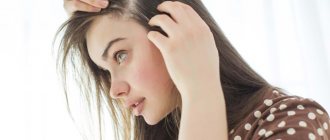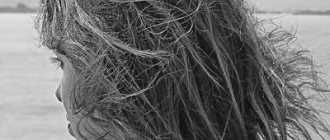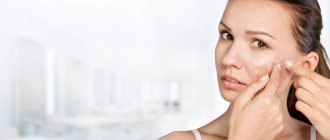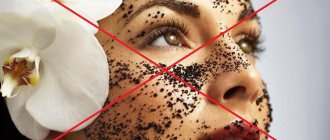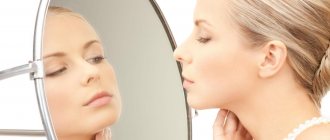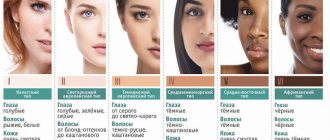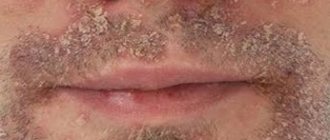Dermatologist (trichologist)
Saperova
Olga Ivanovna
Doctor
Make an appointment
Alopecia areata is a process of progressive hair loss on the scalp or other hairy areas of the skin. This form of pathology rarely leads to complete baldness of the patient. Areas of complete absence of hair alternate with areas of healthy hair. The main cause of alopecia areata is stressful conditions experienced by adults and children. Pathology develops equally often in men and women. The condition of focal baldness does not threaten the health of patients, but is considered by them as a pronounced cosmetic defect.
Etiology of the disease
The causes of alopecia areata are varied. Thus, girls often experience hair loss due to physiological changes in the body during pregnancy. Manifestations of pathology are also possible in the postpartum period. Similarly, taking certain medications orally can affect your hair:
- retinoids;
- hormonal contraceptives;
- anticoagulants.
The risk group includes patients who are under constant stress. Endocrine disorders have a significant impact on the condition of the hair. Lack of iron or zinc and treatment of anemia can trigger the development of alopecia areata.
Loss of growing hair often occurs due to intoxication of the body with bismuth, arsenic, boric acid, and salts of heavy metals. Hair density can rapidly decrease as the patient undergoes radiation therapy. A significant deterioration in the condition of hair follicles is observed in individuals suffering from mycoses of various origins.
Alopecia areata occurs suddenly. The lesions have a round shape, their size can vary from 25-30 to 80-100 mm. The exact reasons for the formation of geometrically adjusted areas of hair loss have not been established. Alopecia of this type is prone to peripheral growth, which can cause total baldness. The lesions are localized on the scalp, but can occur in the area of the eyebrows, eyelashes, beard and mustache. In rare cases, hyperemia appears at the site of lost hair.
How is alopecia areata treated?
Very often on the Internet you can find advice on how to deal with baldness at home. However, these tips do not apply to the treatment of alopecia areata. Real, working treatment is only possible under the supervision of a doctor. Modern medicine has all the ways to quickly and successfully combat the disease.
Diagnostics.
You should visit a doctor at the first signs of baldness. To establish or exclude the diagnosis of alopecia areata, a thorough medical examination and informative studies are necessary:
- preliminary inspection;
- scraping from the scalp;
- blood tests: general, biochemistry and to detect changes in hormonal levels;
- studies of antibody levels (enzyme immunoassay);
- computer hair diagnostics;
- microscopic examination of hair.
The doctor will check the state of the immune system, the presence of a hereditary predisposition to alopecia, the condition of the hair and hair follicles. In addition, it is necessary to exclude diseases whose symptoms are similar to alopecia areata, or those that can provoke its development: systemic lupus erythematosus, trichophytosis, psoriasis, ischemia, syphilis, etc.
Unfortunately, not every hospital is a medical organization with a trichologist. If there is no such specialist in your city, you can seek advice from a dermatologist or therapist. It is also advisable to consult a psychoneurologist, as well as highly specialized specialists.
| Attention! In 70–80% of cases, alopecia areata goes away on its own. However, this is not a reason to ignore visiting a specialist, since without proper treatment there remains a danger that a relapse will occur and the disease will become chronic: this happens in half of these cases. |
Conservative treatment
Treatment methods for alopecia areata are highly individual. First, doctors will cure the diseases that cause alopecia, and only after that they will deal directly with your curls. The goal of drug therapy is to stop hair loss and accelerate its growth throughout the entire area of baldness.
Typically, the treatment regimen includes:
- anti-inflammatory drugs;
- corticosteroid hormones;
- vasodilators;
- medications that improve blood microcirculation;
- sedatives;
- vitamin complexes and biostimulants.
Prescribed drugs for external use:
- lotions, tinctures, ointments, creams with heparin to improve the trophism of small vessels;
- ointments and masks that have an irritating effect - with onion juice, bodyaga, tincture of red pepper, etc.;
- regenerating ointments;
- hormonal agents (glucocorticoids) - if the disease rapidly progresses.
Modern medications make it possible to cure alopecia areata and restore hair growth even in severe stages of the disease. Therapy may cause certain side effects (nausea, drowsiness, minor weight fluctuations, etc.). However, although unpleasant, these reactions do not pose a risk to human health and are not a reason to stop treatment.
Attention! To achieve a positive result, you need to undergo a course of treatment, which is at least three weeks. It may be increased due to the complicated course of the disease.
Physiotherapeutic procedures
Good results in the treatment of alopecia areata are achieved by a properly selected set of physiotherapy procedures. Physiotherapy has virtually no side effects and acts specifically, improving blood circulation and tissue nutrition in the affected areas. It has been noted that treatment with physiotherapeutic methods provides almost complete healing and eliminates the risk of relapse. The procedures have no age restrictions, but the type of exposure and its duration should be selected only under the supervision of a doctor.
Common manual and hardware treatment methods:
- darsanval;
- PUVA therapy;
- cryomassage;
- galvanization of the collar area;
- electromagnetic influence;
- electroporation;
- bioptron;
- electrophoresis;
- ultrasound therapy;
- heat treatment;
- iontophoresis;
- massage.
Many doctors advise patients to undergo microneedling of the scalp. Mesotherapy cocktails and helium-neon laser treatment are also actively used.
| Attention! If the cause of alopecia areata is autoimmune, then you need to be treated as carefully as possible, under the close supervision of a doctor. In case of immunity disorders, many physiotherapeutic interventions are contraindicated for the patient, as well as locally active substances that cause blood flow to the follicles. |
Psychological help
Psycho-emotional stress is not only one of the causes of alopecia areata, but also an indispensable condition of carriers of this pathology. It has long been known that the health of the body, especially hair and skin, is directly related to a person’s psycho-emotional well-being. Therefore, treatment of alopecia areata brings faster and more lasting results if a psychologist is involved in it.
The task of the psychologist is to identify typical problems that arise in the patient in personal, industrial, and social relationships; achieve changes in behavior and self-awareness to achieve peace of mind for the patient. When working with cases of baldness, psychologists use both medicinal and non-medicinal methods:
- medications that affect the central nervous system;
- herbal medicine;
- homeopathy;
- neuro-linguistic programming;
- Ericksonian hypnosis;
- cognitive-behavioral psychotherapy;
- psychoanalysis;
- other methods of psychotherapy.
Stress and fear cause a defensive reaction in the body: the tension is taken over by the hair follicle, which dies due to spasm of blood vessels and muscles. The specialist, by relieving tension, literally brings hair follicles back to life. Some cases of relapse of alopecia areata can be stopped only by a short repeated session of psychotherapy. Attention! All treatment methods require long and painstaking work under the supervision of doctors. You need to set yourself up for a positive result, work closely with specialists, and strictly follow their recommendations.
Home care
Alopecia areata is usually not treated in a hospital setting, and therefore most of the doctor’s recommendations will need to be followed at home. It is very important not to forget about taking medications and applying lotions and ointments in a timely manner. However, if you do not adjust the general principles of hair care, a positive result will be difficult to achieve.
How should you care for hair with symptoms of alopecia?
- eat a balanced diet;
- get rid of bad habits;
- establish a work and rest schedule;
- give the body regular physical activity;
- do self-massage of the head regularly;
- wash your hair whenever it gets dirty;
- select shampoo based on hair type;
- wash and comb your hair carefully;
- use specialized shampoos to accelerate hair growth and improve the structure of follicles;
- dry your hair without using a hair dryer;
- refrain from chemical effects on hair: dyeing, curling, etc.
The principles of careful and careful care must be followed after recovery from alopecia, as well as in order to never encounter such a disease. After all, it is much easier to prevent a disease than to later deal with it and its consequences.
Attention! When treating alopecia areata, it is important to have a comprehensive effect on the body, as well as to use locally acting agents to normalize hair growth. Please note that topical preparations contain poppy oil and lecithin - they accelerate the normalization of hair structure, metabolism and regeneration of skin cells.
Symptoms
A careful examination of the affected area allows you to see the mouths of the hair follicles. Peripheral growth of alopecia lesions can lead to their fusion. The edge of the "nest" contains loose hair that falls out with little impact. Their roots are devoid of pigmentation. The hair ends in a thickening in the form of a white dot. The absence of this symptom indicates that alopecia areata has stopped progressing and has entered the stationary stage.
With a decrease in physical and emotional stress, the patient can count on the restoration of the previous hair density in areas of baldness. The recovery period can last several years. At the first stage, thin, colorless hair appears. Over time, they acquire their usual structure and pigmentation. Regression of alopecia is a reversible process; relapse can occur under the influence of the primary factor of baldness or for another reason.
Are you experiencing symptoms of alopecia areata?
Only a doctor can accurately diagnose the disease. Don't delay your consultation - call
Stages of alopecia
- Spicy.
During this period, the hair roots become thinner, and additional unpleasant phenomena occur: itching and burning in the area of hair loss, redness and inflammation of the skin.
- Subacute.
Baldness is not accompanied by inflammation, or it is slight. There are also no associated unpleasant sensations.
- Regression stage.
Hair stops falling out. Bald spots begin to become covered with “fluff,” which is gradually replaced by normal strands.
Diagnostics
The diagnosis is made during an examination of the patient by a trichologist. The doctor notes a decrease in hair density and the appearance of areas of complete baldness. A mechanical test is carried out - pulling the hair shaft leads to its easy removal from the place of growth.
Identifying the causes of alopecia will allow the doctor to develop an effective course of treatment. The patient receives a referral for tests. Laboratory tests of the blood of a child or adult will reveal a reduced number of T and B lymphocytes. Their deficiency is typical for alopecia areata, which arises against the background of psycho-emotional stress.
Microscopy of the hair shaft makes it possible to exclude mycoses from the patient's history. Trichologists often perform skin biopsies on areas of alopecia. Examination of a biopsy specimen under a microscope makes it possible to detect signs of systemic lupus erythematosus, sarcoidosis or lichen planus. Spectral analysis of hair provides information about its saturation with microelements.
Causes
To date, the true causes of the formation of alopecia areata have not been established. But based on the research, experts have identified the main risk factors:
- Hereditary factor. According to long-term observations, the patient’s relatives have a high risk of developing alopecia areata.
- Stress. It is no secret that constant stressful situations cause many diseases.
- Infectious diseases. These also include fungal skin diseases.
- Failure in the immune system. It is this factor that a separate group of scientists considers to be the main factor in the occurrence of the disease.
- Injuries. Very often, damaged areas of baldness appear after lacerations and puncture wounds, cuts, and blows to the head.
Treatment
Maintaining good hygiene is an important aspect of alopecia treatment. The focal form of the pathology allows you to wash your hair daily (which is unacceptable in case of seborrheic lesions of the scalp). Patients should use neutral shampoos that do not contain emollients or other complex ingredients.
Individuals suffering from alopecia areata are prescribed oral vitamins and minerals. This measure is designed to normalize metabolic processes in the body of a child or adult and stimulate hair growth.
Diet has a significant impact on the success of treatment. The diet should include foods high in zinc. Patients are advised to regularly consume liver, fish, grains, mushrooms, fresh vegetables, and orange juice. During the treatment period, you must give up coffee, alcohol and cigarettes. Their absence will allow the autonomic nervous system to return to normal. The presence of ethanol metabolites in the patient's body can reduce the effectiveness of drug therapy.
Stimulation of hair growth in case of alopecia areata is carried out with the help of furocoumarin drugs, the list of which is contained in the clinical recommendations of the Ministry of Health. The schedule for the use of these funds is determined by the trichologist based on test results and the clinical picture of the pathology. The child or adult is scheduled to attend regular check-ups to assess progress in treating patchy hair loss.
How does alopecia areata manifest?
With alopecia areata, the hair on the scalp falls out, forming distinct round or oval spots (foci, nests). At first they are small, up to several millimeters in diameter, then increase in size. It happens that bald skin swells, turns red, and may experience burning and itching.
The hairs growing along the edges of the affected area become thin, fragile, and are easily pulled out. If you examine such a hair and its root under a microscope, you will see that the shaft tapers towards the base and, together with the dead root, resembles an exclamation mark. This type of hair is one of the main signs of alopecia areata.
The disease begins suddenly, can develop for a long time and inactively, or can very rapidly. It appears at any age, but usually its peak occurs between 15 and 35 years. Most often it affects brunettes. Occurs in one of the following forms:
- locally: hairless “nests” appear on the head, having clear rounded contours;
- ribbon-like: a whole “ribbon” of scalp goes bald from the back of the head to the temples;
- subtotal: initially, small lesions appear throughout the head, which eventually increase and merge;
- Totally: hair falls out all over the head, loss of eyelashes and eyebrows is possible.
The disease can last for years, either dying down or affecting new areas. There is a sudden cessation of the disease and complete restoration of hair in places where it previously fell out. Most often, periods of remission alternate with exacerbations. If the disease manifests itself for six months or longer, then it is said to be a chronic disease.
| Attention! If, along with hair loss, damage to the nail plates is observed - the nails become thinner, deformed, and break - then we are talking about a complicated form of the disease, which will require more time to heal. |
What health conditions can cause total alopecia?
Determining the causes of total alopecia can be very difficult due to the fact that the disease is mainly provoked by autoimmune factors, the diagnosis of which is also not an easy task. Today, most doctors dealing with this problem agree that the main cause of total alopecia is the abnormal behavior of lymphocytes, which negatively affect the hair follicle, disrupting its natural life cycle, causing the hair to “age” faster and fall out.
At the same time, there are some non-basic, but also important factors that can influence the course of the disease. First of all, it is worth noting the influence of drug therapy in the treatment of other serious diseases. Everyone knows that, for example, during chemotherapy, hair can fall out everywhere. Also, in some cases, a particularly sensitive organism may respond in a similar way to long-term use of strong antibiotics. This category of causes of total alopecia also includes exposure to radiation on the human body (for medical purposes or as a result of being in places with high background radiation).
The second group of causes of radical hair loss includes various hormonal disorders. In particular, this explains why alopecia totalis can occur in both women and men. Increased levels of testosterone in the body are a universal risk factor for hair loss. And it can be caused by diseases of the thyroid gland and ovaries in women (polycystic disease, for example), and even pregnancy, when global hormonal changes occur.
The disease can also be provoked by a deficiency of some important nutrients, which is often observed with long-term adherence to strict unhealthy diets. A diet that limits protein and iron intake can be especially dangerous for hair growth. Therefore, it is important for the doctor to take this point into account when making a diagnosis.
Other causes of total alopecia also include head trauma, especially serious and fungal skin diseases.


